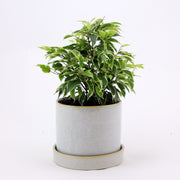Ficus & Trees
Ficus & Trees
Rubber Plant 'Belize' Pink
Ficus Elastica Tineke
Weeping Fig ‘Kinky’
Ficus Mix 5L
This Collection portraits a variety of Fruit Trees, Fig Trees & Rubber Trees as well as our beloved Ficus Bonsais, with that ancient elegance and regular ease of care that characterizes them. Navigate through different sizes, room types, light level and price.
Combine calmness with nature, choose your favourites and get all trees sizes delivered to your door!
Ficus & Trees FAQ
How to Care for Ficus & Indoor Trees?
You should only water once the topsoil is dry as trees very much dislike being over-watered. Make sure the roots aren’t sitting in water either, or your plant may develop root rot, lose its leaves and struggle to recover. Ensure this by checking the bottom of your plant’s container 20 minutes after watering. If there is any excess water in the bottom, just pour it away.
These lovely house plants like a high level of humidity. Consider keeping your Fiucs plants on a tray filled with pebbles and water or mist the leaves regularly to maintain a decent level of humidity.
Ficus can be hungry, fast-growing plants in the right conditions and need lots of nutrition! Fertilise your Ficus Tree once a month in spring and summer and every other month in autumn and winter to make sure it gets all the nutrients it needs.
They prefer temperatures of about 20 °C but should tolerate temperatures anywhere above 15 °C. Ficus plants hate draughts and direct sunlight will scorch the leaves, so you should endeavour to keep them in a spot that maintains a pretty constant temperature away from doors and windows. They usually like bright indirect light but the variegated Ficus can tolerate medium light, so check your particular species’ care!
How to Propagate a Ficus Tree?
Propagate your Ficus to make more awesome plants for you, your friends and your family! Ficus are fast-growing plants, so pruning them frequently can help them be shapely and prevent them from growing out of control. When pruning, you could consider propagation. The most effective way of doing this is by using the air layering method.
Air Layering to Propagate your Ficus
This method has a high rate of success. It encourages new roots on the branch while still attached to the tree.
Use a sharp clean knife to cut a slanted incision ⅓ way into the branch you want to propagate. This should be done around 40 cm from the tip of the branch.
Remove the leaves from around the cut and pack the incision with moist sphagnum moss, wrapping more around until there is a ball encapsulating it. Use cling film to wrap this ball and secure it with tape to retain moisture.
In a few weeks, you should start to see the root system forming inside the moss ball. When there is a generous amount of new roots, cut off the branch just below the root ball, remove the plastic wrap and plant this in a new pot with fresh potting soil.
Which Types of Ficus Trees do exist?
Ficus Ginseng Bonsai
Make your space a little more zen with this impressive Ficus Ginseng Bonsai. Over 15 years old already, this Bonsai is really easy to care for and only needs a little water when the topsoil dries out.
Weeping Fig 'Kinky'
A natural air purifier, the Weeping Fig ‘Kinky’ has teardrop-shaped leaves that are a beautiful vibrant green. Makes a wonderful indoor tree.
Dwarf Weeping Fig Tree
With similar foliage to the Weeping Fig ‘Kinky’, this tree is great for small spaces like flats or smaller rooms like bathrooms where it will thrive in humidity. Just make sure it gets enough indirect light!
Ficus Elastica 'Tineke'
This incredible variegated Rubber Plant has the most gorgeous foliage, with splodges and stripes individual to every leaf. A really impressive plant to add to your collection.
Rubber Plant Belize
As a juvenile, this rare plant has pretty pink and burgundy tinges to its leaves. It produces latex as its sap, hence the name, and its big leaves help purify the air.
Fiddle Leaf Fig
An ornamental Ficus, this plant does not produce fruit but it has stunning large foliage and will make your home feel inviting.
How do I make my Ficus grow faster?
The growing season for the Ficus is spring to summer, so fertilising it every few weeks should encourage it to grow faster during this period. Use well-diluted general house plant feed for this. During winter, the Ficus is dormant, so you should not use any fertiliser or water it too frequently. More indirect light could help it to grow faster too, so consider putting it in a brighter room (and mist regularly). Try not to move it around too much as this can cause it to drop leaves!
Are Ficus trees and fig trees the same thing?
Fig trees are part of the Ficus genus. The edible fig is cultivated from the Ficus carica and all Ficus belong to the plant family Moraceae. Other Ficus have the capability of growing fruit, but they do so mostly in their natural habitat. Any fruit that does grow is not edible to humans, and the plants themselves are toxic, with the sap being slightly irritant.


























